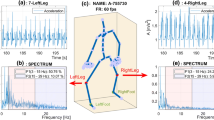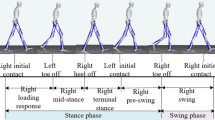Abstract
A portable gait analysis and activity-monitoring system for the evaluation of activities of daily life could facilitate clinical and research studies. This current study developed a small sensor unit comprising an accelerometer and a gyroscope in order to detect shank and foot segment motion and orientation during different walking conditions. The kinematic data obtained in the pre-swing phase were used to classify five walking conditions: stair ascent, stair descent, level ground, upslope and downslope. The kinematic data consisted of anterior–posterior acceleration and angular velocity measured from the shank and foot segments. A machine learning technique known as support vector machine (SVM) was applied to classify the walking conditions. SVM was also compared with other machine learning methods such as artificial neural network (ANN), radial basis function network (RBF) and Bayesian belief network (BBN). The SVM technique was shown to have a higher performance in classification than the other three methods. The results using SVM showed that stair ascent and stair descent could be distinguished from each other and from the other walking conditions with 100% accuracy by using a single sensor unit attached to the shank segment. For classification results in the five walking conditions, performance improved from 78% using the kinematic signals from the shank sensor unit to 84% by adding signals from the foot sensor unit. The SVM technique with the portable kinematic sensor unit could automatically recognize the walking condition for quantitative analysis of the activity pattern.







Similar content being viewed by others
References
Begg R, Kamruzzaman J (2005) A machine learning approach for automated recognition of movement patterns using basic, kinetic and kinematic gait data. J Biomech 38(3):401–408
Begg RK, Palaniswami M, Owen B (2005) Support vector machines for automated gait classification. IEEE Trans Biomed Eng 52(5):828–838
Boser BE, Guyon IM, Vapnik VN (1992) A training algorithm for optimal margin classifiers. In: 5th Annual ACM Workshop on COLT, Pittsburgh, pp 144–152
Chau T (2001) A review of analytical techniques for gait data. Part 1: Fuzzy, statistical and fractal methods. Gait Posture 13(1):49–66
Chau T (2001) A review of analytical techniques for gait data. Part 2: neural network and wavelet methods. Gait Posture 13(2):102–120
Christopher MB (2007) Pattern recognition and machine learning. Springer, Heidelberg
Coleman KL, Smith DG, Boone DA, Joseph AW, del Aguila MA (1999) Step activity monitor: long-term, continuous recording of ambulatory function. J Rehabil Res Dev 36(1):8–18
Coley B, Najafi B, Paraschiv-Ionescu A, Aminian K (2005) Stair climbing detection during daily physical activity using a miniature gyroscope. Gait Posture 22(4):287–294
Cortes C, Vapnik V (2005) Support-vector networks. Mach Learn 20(3):273–297
Dai R, Stein RB, Andrews BJ, James KB, Wieler M (1996) Application of tilt sensors in functional electrical stimulation. IEEE Trans Rehabil Eng 4(2):63–72
Dejnabadi H, Jolles BM, Casanova E, Fua P, Aminian K (2006) Estimation and visualization of sagittal kinematics of lower limbs orientation using body-fixed sensors. IEEE Trans Biomed Eng 53(7):1385–1393
Ethem A (2004) Introduction to machine learning (adaptive computation and machine learning). Mass: MIT Press, Cambridge
Haeuber E, Shaughnessy M, Forrester LW, Coleman KL, Macko RF (2004) Accelerometer monitoring of home- and community-based ambulatory activity after stroke. Arch Phys Med Rehabil 85(12):1997–2001
Hansen M, Haugland MK, Sinkjaer T (2004) Evaluating robustness of gait event detection based on machine learning and natural sensors. IEEE Trans Neural Syst Rehabil Eng 12(1):81–88
Herren R, Sparti A, Aminian K, Schutz Y (1999) The prediction of speed and incline in outdoor running in humans using accelerometry. Med Sci Sports Exerc 31(7):1053–1059
Kamruzzaman J, Begg RK (2006) Support vector machines and other attern recognition approaches to the diagnosis of cerebral palsy gait. IEEE Trans Biomed Eng 53(12 Pt 1):2479–2490
Lau H, Tong K (2008) The reliability of using accelerometer and gyroscope for gait event identification on persons with dropped foot. Gait Posture 27:248–257
Luinge HJ, Veltink PH (2005) Measuring orientation of human body segments using miniature gyroscopes and accelerometers. Med Bio Eng Comput 43(2):273–282
Mayagoitia RE, Nene AV, Veltink PH (2002) Accelerometer and rate gyroscope measurement of kinematics: an inexpensive alternative to optical motion analysis systems. J Biomech 35(4):537–542
Michalski RS, Carbonell JG, Mitchell TM (1983) Machine learning: an artificial intelligence approach, vol I. Morgan Kaufmann, Los Altos
Michalski RS, Kodratoff Y, Bareiss R (1990) Machine learning: an artificial intelligence approach, vol III. Morgan Kaufmann, San Mateo
Najafi B, Aminian K, Loew F, Blanc Y, Robert PA (2002) Measurement of stand-sit and sit-stand transitions using a miniature gyroscope and its application in fall risk evaluation in the elderly. IEEE Trans Biomed Eng 49(8):843–851
Pappas IP, Popovic MR, Keller T, Dietz V, Morari M (2001) A reliable gait phase detection system. IEEE Trans Neural Syst Rehabil Eng 9(2):113–125
Perl J (2004) A neural network approach to movement pattern analysis. Hum Mov Sci 23(5):605–620
Riener R, Rabuffetti M, Frigo C (2002) Stair ascent and descent at different inclinations. Gait Posture 15(1):32–44
Sabatini AM, Martelloni C, Scapellato S, Cavallo F (2005) Assessment of walking features from foot inertial sensing. IEEE Trans Biomed Eng 52(3):486–494
Shimada Y, Ando S, Matsunaga T, Misawa A, Aizawa T, Shirahata T, Itoi E (2005) Clinical application of acceleration sensor to detect the swing phase of stroke gait in functional electrical stimulation. Tohoku J Exp Med 207(3):197–202
Song KM, Bjornson KF, Cappello T, Coleman K (2006) Use of the StepWatch activity monitor for characterization of normal activity levels of children. J Pediatr Orthop 26(2):245–249
Terrier P, Aminian K, Schutz Y (2001) Can accelerometry accurately predict the energy cost of uphill/downhill walking? Ergonomics 44(1):48–62
Tong K, Granat MH (1999) A practical gait analysis system using gyroscopes. Med Eng Phys 21(2):87–94
Tong KY, Mak AF, Ip WY (2003) Command control for functional electrical stimulation hand grasp systems using miniature accelerometers and gyroscopes. Med Biol Eng Comput 41(6):710–717
Vapnik V (1995) The Nature of Statistical Learning Theory. Springer, New York
Williamson R, Andrews BJ (2000) Gait event detection for FES using accelerometers and supervised machine learning. IEEE Trans Rehabil Eng 8(3):312–319
Zhang K, Werner P, Sun M, Pi-Sunyer FX, Boozer CN (2003) Measurement of human daily physical activity. Obes Res 11(1):33–40
Acknowledgments
This project was supported by the Research Grants Council of the Hong Kong Special Administrative Region, China (grant no. PolyU 5284/06E).
Author information
Authors and Affiliations
Corresponding author
Rights and permissions
About this article
Cite this article
Lau, HY., Tong, KY. & Zhu, H. Support vector machine for classification of walking conditions using miniature kinematic sensors. Med Biol Eng Comput 46, 563–573 (2008). https://doi.org/10.1007/s11517-008-0327-x
Received:
Accepted:
Published:
Issue Date:
DOI: https://doi.org/10.1007/s11517-008-0327-x




